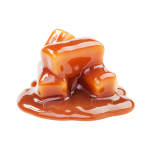 The term “caramel” has two meanings: the highest stage of heated sugar (also caramelized/caramelization) and a confection (candy). According to the food historians, caramelization was practiced in France in the 17th century. Pralines are an example of a caramelized confection. Caramel candies, as we think of them today, surfaced in the 18th century. They are related to toffee. In addition to candy, caramel has several other applications. These include: flavoring (caramel custard), sauce (popular with ice cream), and coating (caramel corn).
The term “caramel” has two meanings: the highest stage of heated sugar (also caramelized/caramelization) and a confection (candy). According to the food historians, caramelization was practiced in France in the 17th century. Pralines are an example of a caramelized confection. Caramel candies, as we think of them today, surfaced in the 18th century. They are related to toffee. In addition to candy, caramel has several other applications. These include: flavoring (caramel custard), sauce (popular with ice cream), and coating (caramel corn).
“Caramel is sugar which has been cooked until it turns brown. The word caramel is a comparatively late introduction into English: it is first recorded in 1725. It came via French from Spanish caramelo, but its previous history is speculative; its most likely source is perhaps late Latin calamellus, a diminutive form of Latin calamus, ‘reed, cane’ (the implied reference being to ‘sugarcane’). The sweets caramels, a soft form of toffee, are made with sugar and milk, butter, or cream.”
Source: Foodtimeline.org



